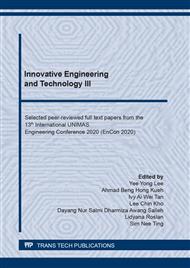[1]
https;//www.google.com/search?q=coconut+shell+product&oq=coconut+shell+&aqs=chrome.4.69i57j017.6698j0j8&sourceid=chrome&ie=UTF-8. Retrieved on 01.07.2020 at 09.00am.
Google Scholar
[2]
K. Gunasekaran, P.S. Kumar, M. Lakshmipathy, Compability studies on the coconut shell cements composites, Indian J Indian Concrete Institute. 11(1) (2010) 27-31.
Google Scholar
[3]
K. Gunasekaran, P.S. Kumar, M. Lakshmipathy, Study on properties of coconut shell as an aggregate for concrete, Indian J Indian Concrete Institute. 12(2) (2011) 27-33.
Google Scholar
[4]
K. Gunasekaran, P.S. Kumar, M. Lakshmipathy, Mechanical and bond properties of coconut shell concrete, Constr Build Mater. 25(1) (2011) 92–98.
DOI: 10.1016/j.conbuildmat.2010.06.053
Google Scholar
[5]
K. Gunasekaran, R. Annadurai, P.S. Kumar, Study on reinforced lightweight coconut shell concrete beam behavior under flexure, Mater Des. 46 (2013) 157–167.
DOI: 10.1016/j.matdes.2012.09.044
Google Scholar
[6]
K. Gunasekaran, R. Annadurai, P.S. Kumar, Plastic shrinkage and deflection characteristics of coconut shell concrete slab, Constr Build Mater. 43 (2013) 203–207.
DOI: 10.1016/j.conbuildmat.2013.02.019
Google Scholar
[7]
K. Gunasekaran, R. Ramasubramani, R. Annadurai, S. Prakash Chandar, Study on reinforced lightweight coconut shell concrete beam behavior under torsion, Mater Des. 57 (2014) 374–382.
DOI: 10.1016/j.matdes.2013.12.058
Google Scholar
[8]
K. Gunasekaran, R. Annadurai, P.S. Kumar, A study on some durability properties of coconut shell aggregate concrete, Mater Struct. 48 (2015) 1253–1264.
DOI: 10.1617/s11527-013-0230-2
Google Scholar
[9]
R.S. Santos, F.A. Rodrigues, N. Segree, I. Joekes, macro-defect free cements: influence of poly(vinyl alcohol), cement type, and silica fume, Cement Concrete Res. 29 (1999) 747-751.
DOI: 10.1016/s0008-8846(99)00070-8
Google Scholar
[10]
M.A. Mannan, J. Alexander, C. Ganapathy, D.C.L Teo, Quality improvement of oil palm shell (OPS) as coarse aggregate in lightweight concrete, Build Environ. 41 (2006) 1239-1242.
DOI: 10.1016/j.buildenv.2005.05.018
Google Scholar
[11]
www.flinnsci/api/library/Download/8dcefc2345ef4072a3d0082316723ad8. Retrieved on 01.02.2020 at 10.00 pm.
Google Scholar
[12]
Yasmine Binta Traore, Adamah Messan, Kinda Hannawi, Jean Gerard, William Prince, Francois Tsobnang, Effect of oil palm shell treatment on the physical and mechanical properties of lightweight concrete, Constr Build Mater. 161 (2018) 452-460.
DOI: 10.17265/2161-6213/2017.5-6.005
Google Scholar


